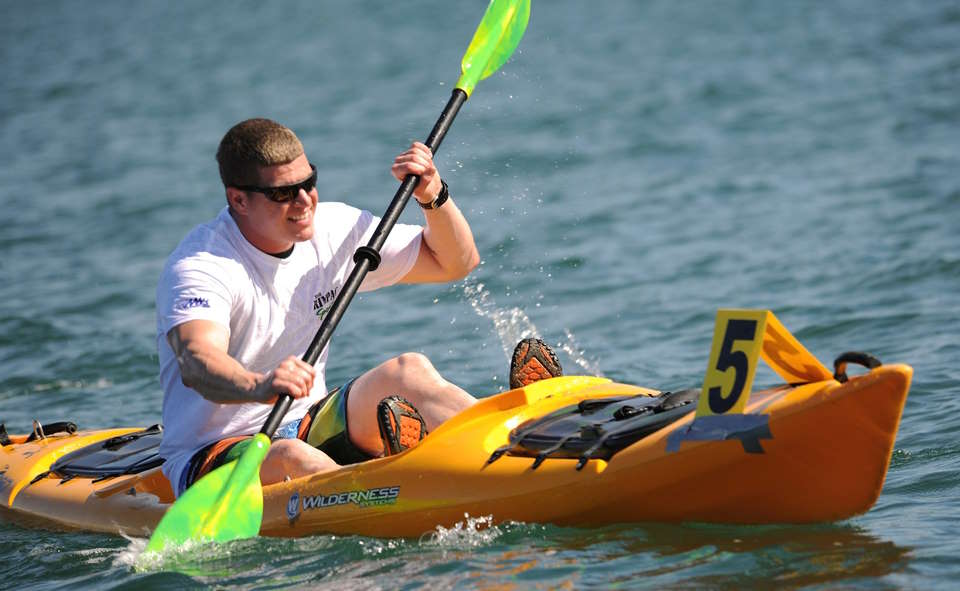Kayaking can be a thrilling and rewarding experience, offering a unique perspective of the great outdoors. However, before you jump in and start paddling, you need to choose the right kayak for your needs and ability. With so many different types and sizes available, selecting the perfect kayak can seem daunting. We’ll explore the key factors to consider when choosing a kayak, including size, type, and design. Whether you’re a beginner or an experienced kayaker, this guide will help you make an informed decision and ultimately get the most out of your time on the water.
Introduction

If you’re new to kayaking, you might be wondering where to start when it comes to choosing the right kayak. With so many different types, sizes, and shapes out there, it can be overwhelming to know which one is right for you. But don’t worry, we’ve got you covered. Here are some tips on how to choose the right kayak for your needs.
- Determine your primary use: The first thing to consider when choosing a kayak is how you plan to use it. Will you be paddling on calm lakes or taking it out on the open sea? Will you be using it for fishing or just for recreational purposes? Answering these questions will help you narrow down your options.
- Consider the size: Another important factor to consider is the size of the kayak. The length and width of the kayak will affect how stable it is on the water and how easy it is to maneuver. Taller individuals will also need a kayak with more legroom.
- Think about materials: Kayaks can be made from a variety of materials, including plastic, composite, and inflatable. Each material has its own pros and cons, such as durability, weight, and price, so it’s essential to think about what’s most important to you.
By taking these factors into consideration, you should be able to find a kayak that suits your needs and interests. Remember to try out different kayaks before making a purchase if possible, and always prioritize safety when out on the water.
How Do I Choose a Kayak for Beginners?

When it comes to kayaking, one of the most commonly asked questions is, “How do I choose a kayak for beginners?” It’s a valid question, especially if you’re new to the sport. Picking the right kayak is essential in ensuring an enjoyable experience out on the water. But with so many options available, it can be overwhelming to know where to start. Here are some key factors to consider when selecting your first kayak.
- Intended use: What do you plan on using your kayak for? Will you be using it for recreational paddling on calm lakes, or do you want to try your hand at more challenging rapids or ocean waters? Knowing your intended use will help you choose a kayak with the appropriate features.
- Type of kayak: There are numerous types of kayaks available including sit-in, sit-on-top, inflatable, and folding kayaks. Each has its own unique advantages and disadvantages based on your intended use and personal preference.
- Size: Kayaks come in various lengths and widths, and selecting the right size for your body type is important in ensuring comfort and stability. Your height and weight will play a role in determining the appropriate kayak size for you.
In addition to the factors mentioned above, you’ll also want to consider the material the kayak is made of, as well as its weight and maneuverability. It’s important to take the time to research and try out different kayaks before making a purchase. Consider renting or borrowing different models to determine what works best for you. By taking these factors into consideration, you can select a kayak that is well-suited for a beginner, setting you up for success and enjoyment in your kayaking adventures.
What Size Kayak Do I Need for My Height?

Choosing the right kayak can be a daunting task, especially when you’re not sure about the size that suits your height. Purchasing the right kayak that fits your height is crucial since it offers a comfortable paddling experience, and you’ll enjoy your time on the water. Most kayak manufacturers provide a size chart that can help you pick the right size that suits your needs.
Before choosing the kayak, you need to measure your height so that you can match it with the kayak’s dimensions. Generally, kayaks range from 6 to 14 feet long, and some can accommodate up to three passengers. If you’re a tall person, a longer kayak size will work best for you. Taller kayakers can paddle with more efficiency in longer kayaks than in shorter kayaks. Most longer kayaks (12 to 14 feet) are for touring and sea kayaking.
On the other hand, short kayaks (6 to 10 feet) are great for maneuvering and turning in narrow channels or windy areas. They’re ideal for shorter kayakers who can easily turn and navigate through tight spaces. However, such kayaks tend to move slower in the water than longer kayaks.

- If you’re between 4’9″ to 5’4″ tall, consider a kayak length of between 9 and 11 feet
- For a height of 5’5″ to 6′, choose a kayak length of 11 to 12.5 feet
- If you’re taller than 6′, pick a kayak that measures 13 to 14 feet in length
| Height (ft/in) | Kayak Length (ft.) |
|---|---|
| 4’9″ – 5’4″ | 9 – 11 |
| 5’5″ – 6′ | 11 – 12.5 |
| Over 6′ | 13 – 14 |
Factors to consider when choosing a kayak size include not only your height but also the intended use for the kayak. A wider and shorter kayak is more stable and is ideal for beginners who are still learning to balance on the water. Longer kayaks are better suited for long trips and provide an easy paddling experience.
What Kind of Kayak Should I Get?

Choosing the right kayak can make or break your experience on the water. With so many options and styles, it can be challenging to determine what kind of kayak you should get. Whether you are a beginner or an experienced paddler, selecting the appropriate kayak should depend on several factors that cater to your needs.
- Type of Kayak: Kayaks come in various styles such as recreational, touring, whitewater, and fishing kayaks. Each type serves a different purpose, so it’s essential to identify what kind of activity you want to do with your kayak. Recreational kayaks are suitable for calm waters and short trips while touring kayaks are designed for extended trips down rivers, lakes, or oceans. Whitewater kayaks have a more maneuverable design for rapid and rough waters, and fishing kayaks offer comfortable seats and ample storage space to take your fishing gear.
- Size and Weight: The size and weight of a kayak should correspond to the paddler’s size, weight, and skill level. Generally, kayaks that are longer and narrower can achieve better speed and tracking while shorter and wider kayaks offer more stability and easy maneuverability. Consider your height and weight when choosing a kayak that can accommodate you comfortably.
- Materials: Kayaks are commonly made of polyethylene plastic, fiberglass, or composite materials, each with its pros and cons. Polyethylene plastic is the most durable and affordable option but tends to be heavier. Fiberglass is lighter and faster, but it’s more prone to damage. Composite materials are the most expensive but offer excellent performance and durability.
- Budget: The price range for kayaks can vary depending on the type, size, and material. Deciding on your budget beforehand can help you narrow down your options and determine what you can afford. Don’t forget to factor in additional costs such as accessories, gear, transportation, and storage.

| Kayak Type | Pros | Cons |
|---|---|---|
| Recreational | Stable, easy to handle, affordable | Slower, less storage space |
| Touring | Longer trips, faster, better tracking | Not as maneuverable, more expensive |
| Whitewater | Maneuverable, durable | Uncomfortable, less storage space |
| Fishing | Comfortable, ample storage space | Slow, heavy, more expensive |
There are many factors to consider when choosing the right kayak, but it all boils down to your needs, budget, and preferences. Take time to test paddle different kayaks if possible, and research online to make an informed decision. With a suitable kayak, you will have an enjoyable and memorable experience on the water.
What Are the Qualities of a Good Kayak?

A good kayak is a valuable investment for anyone who enjoys spending time on the water. But with so many kayaks available on the market, it can be difficult to determine which one will best suit your needs. One way to narrow down your options is by looking at the qualities that make a good kayak.
The first quality to consider is stability. A stable kayak means less risk of tipping over or feeling unsteady in rough waters. The kayak should also have good tracking, which means it travels in a straight line without having to constantly adjust your paddling technique.
- Stability
- Good tracking
Another important quality is comfort. A comfortable kayak will allow you to spend more time on the water without feeling cramped or fatigued. Look for kayaks with comfortable seats, adjustable footrests, and plenty of legroom.
Durability is also key. A good kayak should be able to withstand rough conditions like rocks, waves, and rough terrain. Kayaks made from high-quality materials like fiberglass or polyethylene are often more durable than those made from cheaper materials.

| Qualities of a good kayak | Description |
|---|---|
| Stability | Less risk of tipping over or feeling unsteady in rough waters |
| Good tracking | Travels in a straight line without having to constantly adjust paddling technique |
| Comfort | Allows for longer periods on the water without feeling cramped or fatigued |
| Durability | Able to withstand rough conditions like rocks, waves, and rough terrain |
Lastly, consider the purpose of the kayak. Different kayaks are designed for different purposes, such as whitewater kayaking or recreational paddling. Determine what type of kayaking you plan to do and choose a kayak that is best suited for that purpose.
What Are the 4 Types of Kayaks?

When it comes to choosing the perfect kayak, one thing that you need to consider is the type of kayak that will best suit your needs. There are several types of kayaks available in the market, and each one is designed to serve a particular purpose. We will look at the four main types of kayaks that you can choose from.
- Sit-On-Top Kayaks: These kayaks are perfect for beginners as they are stable and easy to maneuver. They have an open cockpit design, which means that you don’t have to sit inside the kayak. One of the benefits of these kayaks is that they are self-draining, which means that you don’t have to worry about getting wet. They are perfect for recreational use, fishing, and touring.
- Inflatable Kayaks: As the name suggests, these kayaks are inflatable and can be easily packed into a small bag. They are perfect for those who have limited storage space or those who want to travel with their kayak. Inflatable kayaks are also lightweight, making them easy to transport. However, they are not as durable as hard-shell kayaks and can be punctured easily.
- Recreational Kayaks: These kayaks are perfect for those who are looking for a comfortable and stable kayak. They are wider than other types of kayaks, which means that they offer better stability and are more comfortable. Recreational kayaks are perfect for paddling on calm waters such as lakes and slow-moving rivers.
- Touring Kayaks: These kayaks are designed for those who want to cover long distances. They are longer and narrower than recreational kayaks, which means that they are faster and more efficient. Touring kayaks are perfect for those who want to explore rivers, lakes, and the sea. They are also designed to handle rougher waters.
So, there you have it, the four main types of kayaks that you can choose from. When choosing a kayak, it’s important to consider your needs and the type of water you’ll be paddling on. We hope that this article has helped you in choosing the right kayak for your needs.




